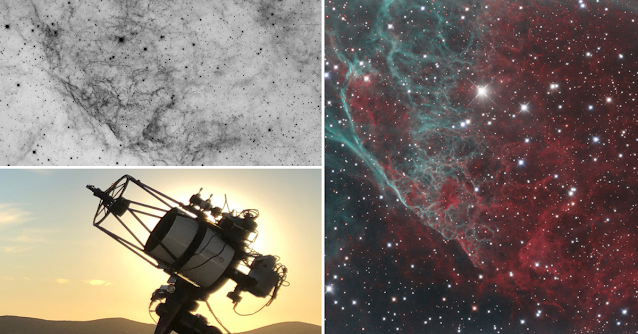There are new image sets available in Starbase, Insight Observatory's image set repository. These sets consist of combinations of H-Alpha, Oxygen III, and Red, Green, and Blue filtered image data of a section of the Vela Nebula (supernova remnant) located in the southern constellation of Vela. These image sets were acquired by Franck Jobard on Insight Observatory's 12.5" f/9 Ritchey-Chretien affiliate remote telescope ATEO-3 hosted at Deep Sky Chile.
The Vela supernova remnant's source Type II supernova exploded approximately 11,000 to 12,300 years ago. The association of the Vela supernova remnant with the Vela pulsar, made by astronomers at the University of Sydney in 1968, was direct observational evidence that supernovae form neutron stars.
This supernova remnant includes NGC 2736. It also overlaps the Puppis A supernova remnant, which is four times more distant. Both the Puppis and Vela remnants are among the largest and brightest features in the X-ray sky.
The Vela supernova remnant (SNR) is one of the closest known to us. The Geminga pulsar is closer (and also resulted from a supernova), and in 1998 another near-Earth supernova remnant was discovered, RX J0852.0-4622, which from our point of view appears to be contained in the southeastern part of the Vela remnant. One estimate of its distance puts it only 200 parsecs away (about 650 ly), closer than the Vela remnant, and, surprisingly, it seems to have exploded much more recently, in the last thousand years, because it is still radiating gamma rays from the decay of titanium-44. This remnant was not seen earlier because, in most wavelengths, it is lost because of the presence of the Vela remnant.
The Moon is the biggest single object in the night sky that’s visible to the eye alone. But many objects that are too faint to see are much bigger. The nebula spans about 16 times the width of the Moon, almost the size of your fist held at arm’s length and it’s getting bigger all the time.
When the supergiant star exploded, blasting its outer layers into space, those layers rammed into surrounding clouds of gas and dust, causing them to glow. If you look across the entire spectrum - from radio waves to X-rays - the nebula looks like a mound of billowing clouds.
When the star exploded, the outer layers were expelled at up to a few percent of the speed of light. So over the millennia, the nebula has inflated to a diameter of more than a hundred light-years. And it’s still expanding - at more than two million miles per hour.
Sources: Wikipedia and Stardate Online.
Read More
The Vela supernova remnant's source Type II supernova exploded approximately 11,000 to 12,300 years ago. The association of the Vela supernova remnant with the Vela pulsar, made by astronomers at the University of Sydney in 1968, was direct observational evidence that supernovae form neutron stars.
 |
| An HaRGB section of the Vela Nebula supernova remnant acquired and processed by Franck Jobard on Insight Observatory's 12.5" f/9 Ritchey-Chretien affiliate remote telescope located at Deep Sky Chile. |
This supernova remnant includes NGC 2736. It also overlaps the Puppis A supernova remnant, which is four times more distant. Both the Puppis and Vela remnants are among the largest and brightest features in the X-ray sky.
The Vela supernova remnant (SNR) is one of the closest known to us. The Geminga pulsar is closer (and also resulted from a supernova), and in 1998 another near-Earth supernova remnant was discovered, RX J0852.0-4622, which from our point of view appears to be contained in the southeastern part of the Vela remnant. One estimate of its distance puts it only 200 parsecs away (about 650 ly), closer than the Vela remnant, and, surprisingly, it seems to have exploded much more recently, in the last thousand years, because it is still radiating gamma rays from the decay of titanium-44. This remnant was not seen earlier because, in most wavelengths, it is lost because of the presence of the Vela remnant.
The Moon is the biggest single object in the night sky that’s visible to the eye alone. But many objects that are too faint to see are much bigger. The nebula spans about 16 times the width of the Moon, almost the size of your fist held at arm’s length and it’s getting bigger all the time.
 |
| Inverted image of the Vela Nebula supernova remnant imaged in Ha (upper left), and in Ha, OIII, and RGB (right), and ATEO-3, the 12.5" f/9 Ritchey-Chretien located at Deep Sky Chile. |
When the supergiant star exploded, blasting its outer layers into space, those layers rammed into surrounding clouds of gas and dust, causing them to glow. If you look across the entire spectrum - from radio waves to X-rays - the nebula looks like a mound of billowing clouds.
When the star exploded, the outer layers were expelled at up to a few percent of the speed of light. So over the millennia, the nebula has inflated to a diameter of more than a hundred light-years. And it’s still expanding - at more than two million miles per hour.
Sources: Wikipedia and Stardate Online.
 |
| Search for Vela Nebula in the "Name" field in Starbase to access the Vela Nebula - Ha 6nm (2021) Vela Nebula - OIII 3nm (2021), and Vela Nebula - RGB (2021) image sets. |





